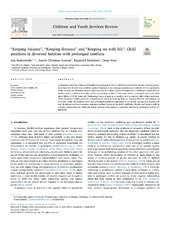| dc.contributor.author | Stokkebekk, Jan | |
| dc.contributor.author | Iversen, Anette Christine | |
| dc.contributor.author | Hollekim, Ragnhild | |
| dc.contributor.author | Ness, Ottar | |
| dc.date.accessioned | 2020-04-03T07:49:16Z | |
| dc.date.available | 2020-04-03T07:49:16Z | |
| dc.date.issued | 2019 | |
| dc.Published | Stokkebekk JK, Iversen AC, Hollekim R, Ness O. “Keeping balance”, “Keeping distance” and “Keeping on with life”: Child positions in divorced families with prolonged conflicts. Children and youth services review. 2019;102:108-119 | eng |
| dc.identifier.issn | 0190-7409 | |
| dc.identifier.issn | 1873-7765 | |
| dc.identifier.uri | https://hdl.handle.net/1956/21673 | |
| dc.description.abstract | A dominant storyline of divorced families in prolonged conflict is children portrayed as victims without agency. How does this fit with how children position themselves in prolonged post-divorce conflicts? In this qualitative study we pose the following research question; how do children position themselves to challenges in post-divorce family conflict, and how is family conflict positioning children? This paper draws on in-depth interviews with nine children (10-16) years old. Positioning theory is used as an analytic tool to explore child subject positions. Three dominant subject positions emerged in the analysis: keeping balance, keeping distance and keeping on with life. While our analyses show that prolonged conflict is oppressive to the family system, it is argued that each dominant position represents resistance against threats to the child’s wellbeing, dignity and being a child in a family. Implications for child and family services with respect to separated families in prolonged conflict are discussed. | en_US |
| dc.language.iso | eng | eng |
| dc.publisher | Elsevier | eng |
| dc.rights | Attribution CC BY | eng |
| dc.rights.uri | http://creativecommons.org/licenses/by/4.0/ | eng |
| dc.subject | Familieterapi / Family therapy | eng |
| dc.subject | Foreldretvister foreldrekonflikter / Custodial conflicts | eng |
| dc.subject | Posisjonerings teori / Positioning theory | eng |
| dc.title | “Keeping balance”, “Keeping distance” and “Keeping on with life”: Child positions in divorced families with prolonged conflicts | eng |
| dc.type | Peer reviewed | |
| dc.type | Journal article | |
| dc.date.updated | 2020-01-10T11:30:58Z | |
| dc.description.version | publishedVersion | |
| dc.rights.holder | Copyright 2019 The Author(s) | eng |
| dc.identifier.doi | https://doi.org/10.1016/j.childyouth.2019.04.021 | |
| dc.identifier.cristin | 1693549 | |
| dc.source.journal | Children and youth services review | |
| dc.relation.project | Barne-, ungdoms og familiedirektoratet (Bufdir): 2016/1915 | |
| dc.subject.nsi | VDP::Samfunnsvitenskap: 200::Psykologi: 260::Andre psykologiske fag: 279 | |
| dc.subject.nsi | VDP::Social sciences: 200::Psychology: 260::Other subjects within psychology : 279 | |
| dc.identifier.citation | Children and youth services review. 2019, 102, 108-119. | |

